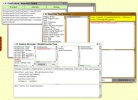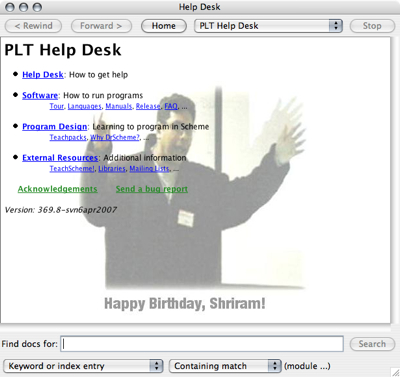Aggressive unit testing (also known, by those willing to earn some easy money, by the buzzword test-driven development) is about the only practice from XP that i embraced happily in my days as a dot com employee (it was around 2000, and i was working for one of those companies that got lots of funding from avid but hopelessly candid investors to do… well, to do basically nothing).
Those were my long gone Java days, and i got test infected all the way down. That writing tests is a good practice is hardly news for any decent programmer, but what i specially liked about putting the stress on writing lots of tests was discovering how conductive the practice is for continuous code rewriting (count that as the second, and last, extreme practice i like). I had yet to discover the real pleasures of bottom-up development in REPL-enabled languages, but even in Java my modus operandi consisted basically in starting with concrete code (sometimes even a mere implementation detail) and make the application grow up from there. Of course, some brainstorming and off-the-envelop diagramming was involved, but the real design, in my experience, only appears after fighting for a while with real code. The first shot is never the right one, nor the second, for that matter. The correct design surfaces gradually, and i know i’ve got it right when unexpected extensions to the initially planned functionality just fit in smoothly, as if they had been foresighted (as an aside, i feel the same about good maths: everything finds its place in a natural way). When you work like that, you’re always rewriting code, and having unit tests at hand provides a reassuring feeling of not being throwing the baby with the bath during your rewriting frenzies.
Of course, there’s also a buzzword-compliant name for such rewritings (refactoring), and you can expend a few bucks to read some trivialities about all that. (Mind you, the two books i just despised have been widely acclaimed, even by people whose opinion i respect, so maybe i’m being unfair here—in my defense, i must say i’ve read (and paid) both of them, so, at least, my opinion has cost me money.)
 Anyway, books or not, the idea behind the JUnit movement is quite simple: write tests for every bit of working code you have, or, if you’re to stand by the TDD tenets (which i tend not to do), for every bit of code you plan to write. As is often the case, the Java guys where not inventing something really new: their libraries are a rip-off of the framework proposed by Kent Beck for Smalltalk. Under the SUnit moniker, you’ll find it in every single Smalltalk implementation these days. A key ingredient to these frameworks’ success is, from my point of view, their simplicity: you have a base test class from which to inherit basic functionality, and extend it to provide testing methods. Languages with a minimum of reflection power will discover and invoke those methods for you. Add some form of test runner, and childish talk about an always green bar, and you’ve got it. The screenshot on the left shows the new SUnit Test Runner in one of my Squeak 3.9 images, but you’ll get a better glimpse of how writing unit tests in Squeak feels like by seeing this, or this, or even this video from Stéphane Ducasse‘s collection.
Anyway, books or not, the idea behind the JUnit movement is quite simple: write tests for every bit of working code you have, or, if you’re to stand by the TDD tenets (which i tend not to do), for every bit of code you plan to write. As is often the case, the Java guys where not inventing something really new: their libraries are a rip-off of the framework proposed by Kent Beck for Smalltalk. Under the SUnit moniker, you’ll find it in every single Smalltalk implementation these days. A key ingredient to these frameworks’ success is, from my point of view, their simplicity: you have a base test class from which to inherit basic functionality, and extend it to provide testing methods. Languages with a minimum of reflection power will discover and invoke those methods for you. Add some form of test runner, and childish talk about an always green bar, and you’ve got it. The screenshot on the left shows the new SUnit Test Runner in one of my Squeak 3.9 images, but you’ll get a better glimpse of how writing unit tests in Squeak feels like by seeing this, or this, or even this video from Stéphane Ducasse‘s collection.
Of course, you don’t need to use an object-oriented language to have a unit testing framework. Functional languages like Lisp provide even simpler alternatives: you get rid of base classes, exchanging them by a set of testing procedures. The key feature is not a graphical test runner (which, as any graphical tool, gets in the way of unattended execution: think of running your tests suites as part of your daily build), but a simple, as in as minimal as possible, library providing the excuse to write your tests. Test frameworks are not rocket science, and you can buy one as cheap as it gets: for instance, in C, i’m fond of MinUnit, a mere three-liner:
/* file: minunit.h */
#define mu_assert(message, test) do { if (!(test)) return message; \
} while (0)
#define mu_run_test(test) do { char *message = test(); tests_run++; \
if (message) return message; } while (0)
extern int tests_run;
(Let me mention in passing, for all of you non-minimalistic C aficionados, the latest and greatest (?) in C unit testing: libtap) Add to this a couple of Emacs skeletons and an appropriate script and you’re well in your way towards automated unit testing. From here, you can get fancier and add support for test suites, reporting in a variety of formats, and so on; but, in my experience, these facilities are, at best, trivial to implement and, at worst, of dubious utility. It’s the quality and exhaustiveness of the tests you write what matters.
Lisp languages have many frameworks available. The nice guys of the CL Gardeners project have compiled a commented list of unit testing libraries for Common Lisp. In Scheme you get (of course) as many testing frameworks as implementations. Peter Keller has written an R5RS compliant library that you can steal from Chicken. Noel Welsh’s SchemeUnit comes embedded into PLT, and the Emacs templates are already written for you (or, if you mileage varies and you’re fond of DrScheme, you can have a stylized version of the green bar too). Personally, i don’t use PLT, and find Peter’s implementation a bit cumbersome (meaning: too many features that i don’t use and clutter the interface). Thus, my recommendation goes to Neil van Dyke of quack‘s fame’s Testeez. Testeez is an R5RS (i.e., portable), lightweight framework that is as simple as possible. Actually, it’s simpler than possible, at least in my book. In my opinion, when a test succeeds it should write nothing to the standard (or error) output. Just like the old good unix tools do. I only want verbosity when things go awry; otherwise, i have better things to read (this kind of behaviour also makes writing automation and reporting scripts easier). So, as a matter of fact, I use a hacked version of Testeez which has customizable verbosity levels. It’s the same version that we use in Spells, and you can get it here. Also of interest are Per Bothner’s SRFI-64, A Scheme API for test suites and Sebastian Egner’s SRFI-78, Lightweight testing (both including reference implementations).
Lisp testing frameworks abound for a reason: they’re extremely useful, yet easy to implement. As a consequence, they’re good candidates as non-trivial learning projects. A nice example can be found in Peter Seibel’s Practical Common Lisp (your next book if you’re interested in Common Lisp), which introduces macro programming by implementing a decent testing library. In the Scheme camp, Noel discusses the ups and downs of DSL creation in an article describing, among other things, the SchemeUnit implementation. A worth reading, even for non-beginners.
Once you settle on a test framework and start writing unit tests, it’s only a question of (short) time before you’re faced with an interesting problem, namely, to really write unit tests. That is, you’re interested in testing your functions or classes in isolation, without relying on the correctness of other modules you’ve written. But of course, your code under test will use other modules, and you’ll have to write stubs: fake implementations of those external procedures that return pre-cooked results. In Lisp languages, which allow easy procedure re-definition, it’s usually easy to be done with that. People get fancier, though, specially in object-oriented, dynamic languages, by using mock objects. The subject has spawn its own literature and, although i tend to think they’re unduly complicating a simple problem, reading a bit about mockology may serve you to discover the kind of things that can be done when one has a reflective run-time available. Smalltalk is, again, a case in point, as Sean Mallory shows in his stunningly simple implementation of Mock Objects. Tim Mackinnon gets fancier with his SMock library, and has coauthored a very interesting article entitled Mock Roles, Not Objects, where mock objects are defined and refined:
a technique for identifying types in a system based on the roles that objects play. In [9] we introduced the concept of Mock Objects as a technique to support Test-Driven Development. We stated that it encouraged better structured tests and, more importantly, improved domain code by preserving encapsulation, reducing dependencies and clarifying the interactions between classes. [...] we have refined and adjusted the technique based on our experience since then. In particular, we now understand that the most important benefit of Mock Objects is what we originally called interface discovery [...]
An accompanying flash demo shows SMock in action inside Dolphin Smalltalk. The demo is very well done and i really recommend taking a look at it, not only to learn to use Mock Objects, but also as a new example of the kind of magic tricks allowed by Smalltalk environments. Albeit not as fanciful, Objective-C offers good reflective features, which are nicely exploited in OCMock, a library which, besides taking advantage of Objective-C’s dynamic nature, makes use of the trampoline pattern (close to the heart of every compiler implementer) “so that you can define expectations and stubs using the same syntax that you use to call methods”. Again, a good chance to learn new, powerful dynamic programming techniques.
As you can see, writing tests can be, a bit unexpectedly, actually fun.
Tags: elisp, emacs, lisp, objective-c, scheme, smalltalk, squeak






 Since last June, i’m working on a project called LISA Pathfinder, a forerunner of the future space-based
Since last June, i’m working on a project called LISA Pathfinder, a forerunner of the future space-based 